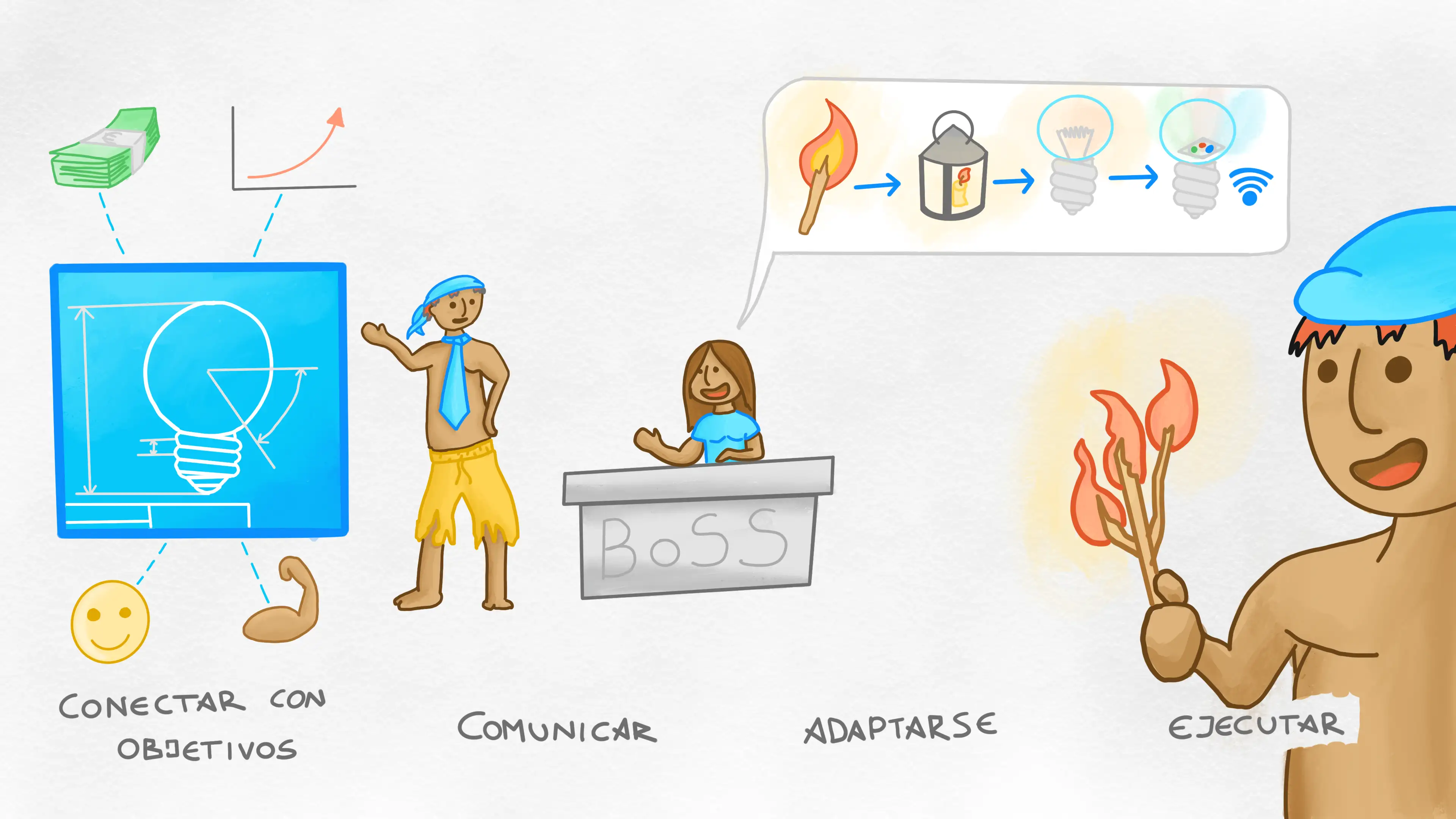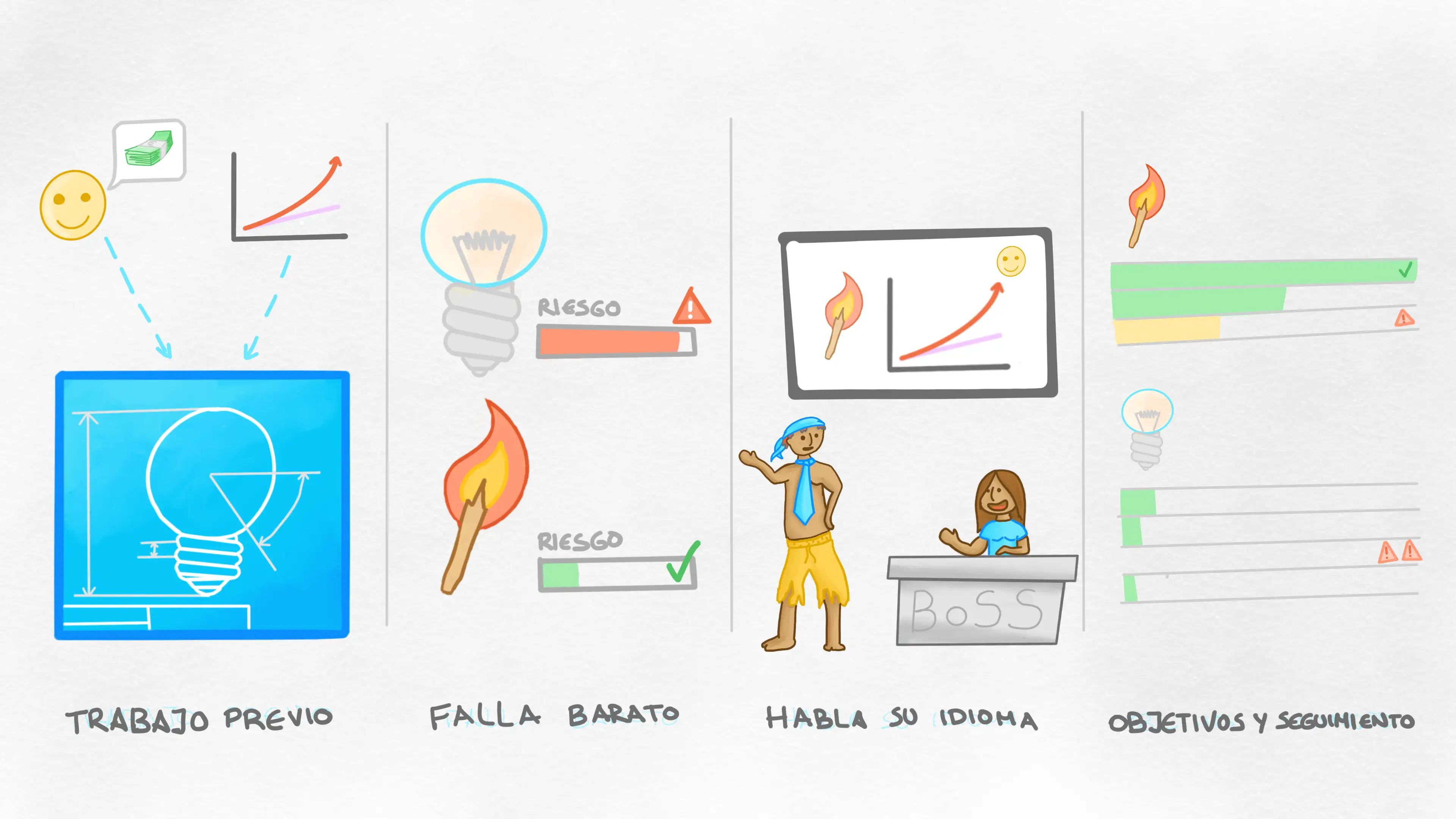How satisfying it is to have good ideas! And how frustrating it is when no one listens to us. In this article, I’ll share the tricks I’ve learned over the years to turn one of your ideas into a reality.
One day, you’re at work, thinking things over, and suddenly, your head lights up. You’ve had a brilliant idea! What if we create a virtual reality app for our product? (For example) Surely, we’d sell tons of it.

You happily go to your boss with your master plan, explain it in detail and…
They tell you it’s unfeasible!
Terrible! They didn’t listen to you, they don’t understand the genius of your idea. Don’t they want to get rich? What a homicidal rage!

Well, breathe, it’s not the end of the world.
By applying a little assertiveness and a bit of wit, you can get your ideas taken more seriously and increase their chances of success when carrying them out. And this is really good for our self-esteem, like every time we achieve something. Not to mention how having that initiative can work wonders for our professional career.

The Ingredients of a Good Idea
Not all ideas are worth pursuing. Many of the tips I’m going to share will help you determine whether an idea is good or not. Knowing when to sell an idea is just as important as knowing when to discard it.
After all, having an idea doesn’t mean much. We can come up with hundreds of ideas in a day. What’s truly important is:
- Connecting them to a bigger context: How it affects users, how it fits into a company’s objectives, etc.
- Communicating: Being able to convey your idea at different levels, and making others feel like it’s their own.
- Adapting: Knowing how to apply feedback from others to fully shape the idea.
- Executing: Building your idea brick by brick, overcoming all the challenges along the way.

4 Golden Rules for Successfully Implementing Ideas
My experience over the years has led me to group my advice into these four golden rules:

Before I start sounding like some all-knowing guru, I want to explain where this advice comes from.
I have a lot of experience managing projects. From a young age, I taught theater and gave private lessons; in university, I led a film group, worked as a camp counselor and director, and coordinated a team raising funds for NGOs. More recently, I managed a team for an American company, with bosses and subordinates thousands of miles away from me.

As you can see, much of this was volunteer work. Motivating a group of volunteers has an added complexity: people are there because they want to be. The moment the project no longer motivates them, they leave. If you force an idea that doesn’t inspire, they leave. If there’s bad energy, they leave.
In the workplace, I’ve encountered a different set of problems, mainly two:
- Incredible egos that don’t fit in this world. These egos will reject any idea that isn’t their own.
- People with incredibly busy schedules who need to hear things that are very polished and clear before they’ll even start considering them.
By sharing this experience, I want to say that I’m not an expert, but I know a thing or two. What worked for me may not work for everyone, but I hope these tips will inspire you to find what works for you.
Now that we’ve set the context, let’s get into the details!
1. Do Your Homework

As we mentioned before, beyond just having an idea, you need to be able to execute it.
Respect others’ time and do some work before presenting an idea.
- Are you willing to execute the idea, or are you going to dump it on others’ shoulders?
- Is it a good idea?
- How does it fit within the overall project vision?
- How does it help achieve the project goals?
- What about your team’s goals?
- What are the costs? (Time, effort, money).
Show that you’re capable of making data-driven decisions.
If you’re unsure about things, ask for help. If you have a good rapport with your colleagues, this could be a great time to call in some favors.
A useful tool is to float trial balloons:
- You: I’ve been thinking about ways to draw attention to our product.
- Boss: Oh? I’m sure marketing would love that.
- You: Lately, I’ve been learning about virtual reality; maybe I could do something with our product.
- Boss: It’s eye-catching, but it doesn’t quite connect with the product.
- You: What do you think marketing would be interested in?
- Boss: They’re looking for something viral, that brings in a lot of visits. Also, something flashy for the next trade show.
- You: Thanks! I’ll keep brainstorming.
As you can see, we didn’t sell our idea. Our boss, instead of getting defensive, adopted a creative and solution-oriented mindset.
We’ll dive deeper into this in the article How to Prepare to Present an Idea?.
2. Fail Cheaply

You might have the best idea in the world, but the universe is a jerk that loves to teach humility.
Accept that you’re going to fail whether a little or a lot, whether on something big or small. The fact is, none of us are perfect.
But failure is good; it helps us learn and makes us better.
- Make failure part of your process.
- Make failure cheap.
How can we do this?
By dividing your project into small parts. You can present the full idea, but focus on a first phase with a limited scope.
If your goals are humble, it’ll be easier to achieve them. You’ll also gain context to guide the next phases of the project.
If the first phase only takes a few hours, even if it fails, the loss is minimal.
In fact, even if you fail, other positive aspects will be valued—like whether you met deadlines or evaluated objectives well. This will build trust for the future.
We’ll dive deeper into this in the article How to Succeed by Failing Cheaply.
3. Speak Your Boss’s Language

It’s time to present our idea!
Here’s where we communicate that:
- You’ve identified a problem or an opportunity.
- You’ve already done some thinking and come up with options.
- You’d like to coordinate the implementation of a solution.
You want people to feel like your idea is their own, and work together to evolve it.
Bosses speak in PowerPoint language, so start with a presentation:
- Present the problems to solve, or the opportunity discovered.
- Describe how your solution changes the situation.
- Briefly outline the MVP (Minimum Viable Product) and the objectives that would validate your idea. Don’t forget to include your estimates for the effort and resources required.
- Optionally, mention other alternatives you’ve considered, and why they’re not suitable.
- Open the floor for other ideas, perspectives, and comments.
If all goes well, you’ll move on to the next phase of the project.
If things go sideways, it’s time to adjust the strategy. Try to find where the disconnect is with your audience.
- Do you agree on the problem?
- Do you agree on the value of the opportunity presented?
- Is the proposed solution the issue?
- Is it a particular detail?
Let others talk, gather context, and use the material you’ve prepared to clarify any misunderstandings.
We’ll dive deeper into this in the article How to Speak Your Boss’s Language.
4. Set Goals and Follow Up

Congratulations! We’ve gotten our idea approved, and now we’re leading a project. 🎉
There’s a lot to do, but don’t try to do everything at once, break it down into small phases. Apply the same “fail cheap” philosophy we used when discussing MVPs.
Above all, set goals for each phase. Communicate those goals and ensure everyone is aligned. Managing expectations is one of the most important jobs in project management.
Once you start, always know how the project is going, especially which areas are at risk. The last thing you or your bosses want is nasty surprises. It’s better to talk about problems while they still have solutions.
Finally, listen and adapt. You’ll receive a lot of feedback and input.
But remember, we don’t need another Titanic!
The sinking of the Titanic could have been avoided by listening to the multiple iceberg warnings in the area.
You need to learn to listen, filter and act.
We’ll dive deeper into this in the article Executing Ideas: Setting Objectives and Tracking Progress.
Offering and Receiving Feedback
If you apply the previous tips you should have a solid base to turn your idea into a reality.
I would like to finish this article saga with some more tips on how to manage feedback and criticism.
Receiving feedback is a signal of success. People liked our idea so much, they want participate, improve upon it, and drop their grain of sand.
- Wenever you receive feedback, make sure to pay attention. Book a meeting at another moment if needed.
- Practice active listening.
- Speak clearly and honestly, without forgeting about asertivity.
- Ask for data.
- If you notice a weak spot, let it be known.
- If you feel there is missing context, offer it.
- Lastly, explain yourself. Don’t make your decissions look random.
Spend time to guiding and teaching, everyone else will feel more realized working with you and you’ll receive better feedback in the future.
Whenever the feedback comes from your higher-ups, ask, and ask again. They usually are busy people that don’t always speak clearly, or that takes things for granted. It’s better to look dumb and do a good job, than wasting time in doing a poor job.
And lastly, stay alert in case you receive lots of feedback that doesn’t make sense. It’s a red flag poiting to the goals not being clear. 🚩
In those cases, it’s better to step back and re-align on the basics.
We’ll dive deeper into this in the article How to Offer and Receive Feedback (and Come Out Looking Good).
Conclusion
Being proactive and presenting ideas is a sign that you are interested in something. But it can also be a source of frustration.
Knowing how to present your ideas and successfully bring them to life will help boost your self-esteem and advance your professional career.
When you present an idea, many things are evaluated. Knowing how to shape and execute it is what will set you apart from others. Even if the idea fails, if you do things well along the way, you will stand out.
Above all, good communication, organization, and assertiveness are the tools that will open more doors for you. Practice them!
If you want to learn more, check out other articles in the series How to Implement Ideas Without Murdering Anyone:
